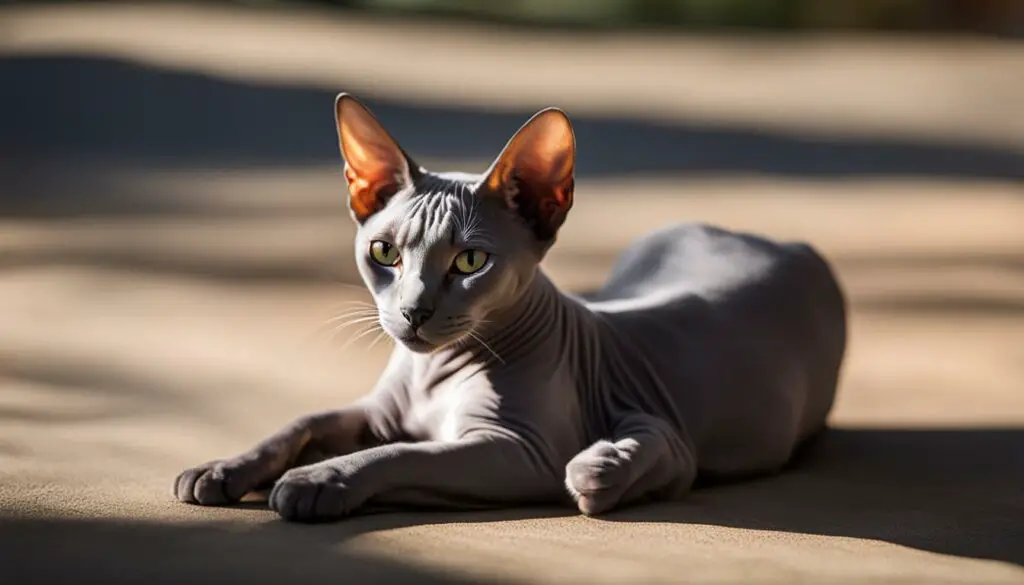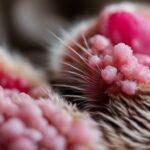Are you ready to meet a truly unique and captivating breed of feline? Allow me to introduce you to the cat with a bald head, also known as a hairless cat. These adorable creatures have gained popularity and stolen the hearts of pet lovers across the United States. One of the most well-known bald cat breeds is the Sphynx cat, which sports little to no hair on its body, creating a distinct and striking appearance.
Curious to learn more about these intriguing felines? Join me as we explore the world of bald cat breeds and uncover the reasons behind their unique look.
Key Takeaways:
- The cat with a bald head, also known as a hairless cat, is a captivating and increasingly popular breed.
- The Sphynx cat is one of the most well-known bald cat breeds, with little to no hair on its body.
- Stay tuned to discover the fascinating reasons behind the hairless appearance of these felines.
- Understanding the distinctive needs and care requirements of bald cats is essential for their well-being.
- Prepare to fall in love with these unique and charming feline companions!
Understanding Cat Hair Loss: Common Causes and Symptoms
Cat hair loss, also known as alopecia, can be a concerning issue for pet owners. It is important to understand the common causes and symptoms associated with cat alopecia in order to provide proper care and treatment. In this section, I will discuss the various factors that can contribute to cat hair loss and the signs to look out for.
Common Causes of Cat Hair Loss
There are several factors that can cause hair loss in cats. Skin conditions, such as infections and allergies, are common culprits. Cats may develop skin infections like ringworm, which can lead to bald spots. Allergies to certain foods, fleas, or environmental factors can also cause cats to scratch excessively and groom their fur off, resulting in hair loss.
Hormonal imbalances can also contribute to cat hair loss. Cats rely on specific hormones for healthy fur growth, and any imbalances in these hormones can lead to bald patches. Additionally, poor health and nutrition can impact a cat’s coat, resulting in hair loss. Cats with underlying diseases or a diet lacking essential nutrients may experience hair loss as a result.
Symptoms of Cat Hair Loss
Identifying the symptoms of cat hair loss is crucial for early detection and treatment. Bald patches on the skin are a common sign of alopecia in cats. These patches may appear red or inflamed and can be accompanied by scabs. Cats with hair loss may also excessively groom or scratch themselves, leading to further hair loss.
If you notice any signs of cat hair loss, it is important to consult a veterinarian. They will be able to diagnose the underlying cause and provide appropriate treatment options. It is crucial to address the root cause of hair loss in order to promote hair regrowth and ensure the overall health and well-being of your feline companion.
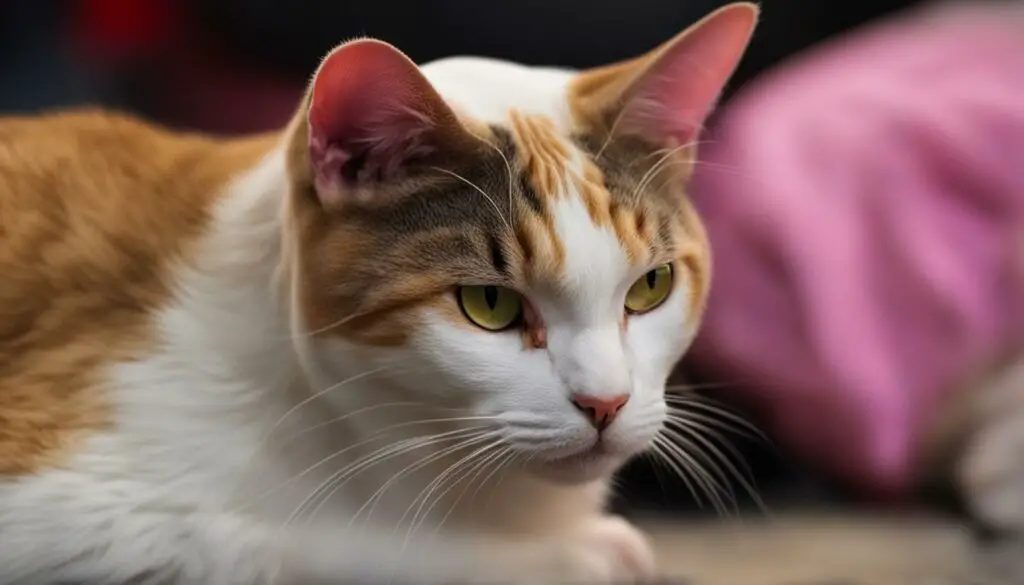
| Cause | Common Symptoms |
|---|---|
| Skin conditions | Bald spots, redness, inflammation, scabs |
| Allergies | Excessive grooming, itching, bald patches |
| Hormonal imbalances | Bald patches, irregular fur growth |
| Poor health and nutrition | General hair loss, dull coat |
“Identifying the symptoms of cat hair loss is crucial for early detection and treatment.”
In conclusion, cat hair loss is a common issue that can be caused by various factors. Understanding the common causes and symptoms associated with cat alopecia is essential for providing proper care and treatment. If you notice any signs of hair loss in your cat, it is important to consult a veterinarian for a proper diagnosis and to develop a tailored treatment plan to address the underlying cause.
Skin Conditions and Cat Hair Loss
When it comes to cat hair loss, skin conditions can play a significant role. Cats may develop infections such as cat ringworm, which is a fungal infection that can cause hair loss. Infestations of parasites like mites or fleas can also result in hair loss as cats excessively scratch and groom themselves. Additionally, cats with allergies may experience a cat skin condition that leads to over-grooming, resulting in bald patches. It’s important to understand and address these skin-related causes of hair loss in cats.
One common skin condition that can contribute to hair loss is cat ringworm. Although it sounds like a worm infestation, it is actually a fungal infection that can affect cats. Cats with ringworm may experience patchy hair loss in various areas of their body, accompanied by scaly or crusty skin. Treating cat ringworm typically involves antifungal medications, regular bathing, and environmental cleaning to prevent its spread.
“The presence of external parasites like fleas or mites can also lead to cat hair loss. These parasites cause itching and discomfort, leading cats to scratch and groom excessively, resulting in the development of bald patches.”
Another cause of hair loss in cats is over-grooming due to allergies. Cats can be allergic to various substances, including certain foods, environmental allergens, or flea bites. Allergic reactions can cause cats to itch and scratch, leading to hair loss. Identifying and managing the allergen is crucial, whether it be through dietary changes, environmental modifications, or allergy medications prescribed by a veterinarian.
To properly diagnose and treat cat hair loss due to skin conditions, it’s important to consult a veterinarian. They can perform the necessary tests, such as skin scrapings or fungal cultures, to identify the specific cause of the hair loss. Treatment options may include medications, topical ointments, dietary adjustments, parasite control, and providing relief from itching and discomfort.
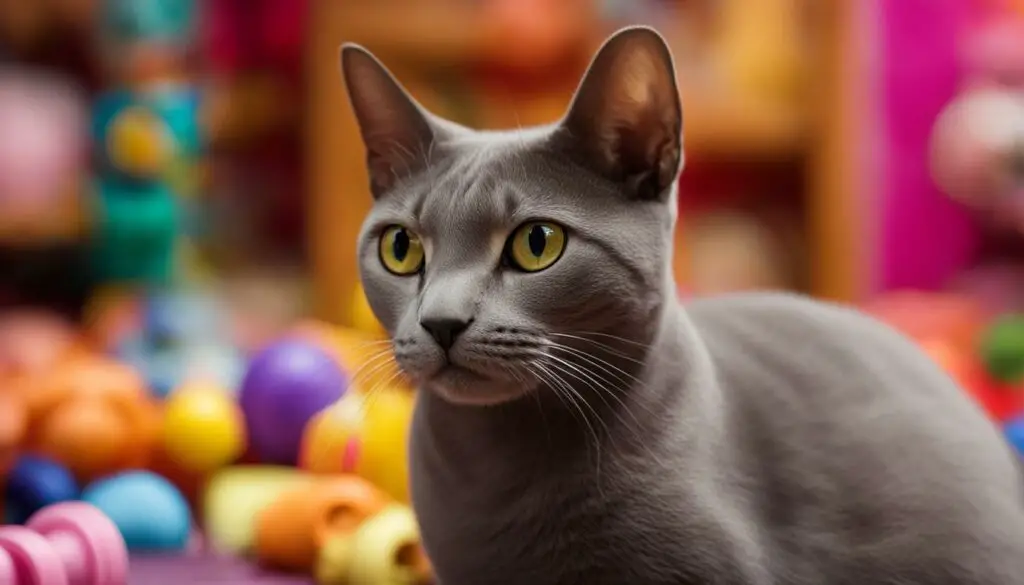
| Skin Condition | Cause | Symptoms | Treatment |
|---|---|---|---|
| Cat ringworm | Fungal infection | Patchy hair loss, scaly/crusty skin | Antifungal medications, bathing, environmental cleaning |
| Parasite infestations | Fleas, mites | Bald patches from excessive scratching | Parasite control, medication for itching |
| Allergies | Foods, environmental allergens, flea bites | Over-grooming, itching, hair loss | Allergen identification, dietary changes, environmental modifications, medication |
Stress and Hair Loss in Cats
Stress can have a significant impact on a cat’s overall well-being, including their coat health. Just like humans, cats can experience stress and anxiety, leading to a variety of physical and behavioral changes. One common result of stress in cats is hair loss or excessive grooming, known as stress-induced hair loss. When a cat is stressed, they may engage in compulsive grooming behaviors as a way to self-soothe, which can lead to bald patches and thinning fur.
Identifying the source of stress in a cat’s environment is essential for addressing the issue and promoting hair regrowth. Common stressors for cats include changes in their routine, introduction of new pets, moving to a new home, or loud noises. Providing a calm and secure environment, along with plenty of mental and physical stimulation, can help alleviate stress and minimize hair loss.
Reducing Stress in Cats
When dealing with a stressed cat, there are several strategies you can implement to help reduce their anxiety and prevent further hair loss:
- Create a safe and quiet space for your cat, with access to hiding spots and elevated areas.
- Use pheromone diffusers or sprays to create a calming environment.
- Establish a consistent routine to provide a sense of predictability.
- Provide interactive toys and playtime to keep your cat mentally and physically stimulated.
- Avoid sudden changes in their environment and introduce new experiences gradually.
If your cat’s stress-induced hair loss persists or worsens despite your efforts, it’s important to consult with a veterinarian. They can assess your cat’s overall health and behavior, recommend further interventions or behavior modification techniques, and address any underlying medical conditions that may be contributing to the stress or hair loss.
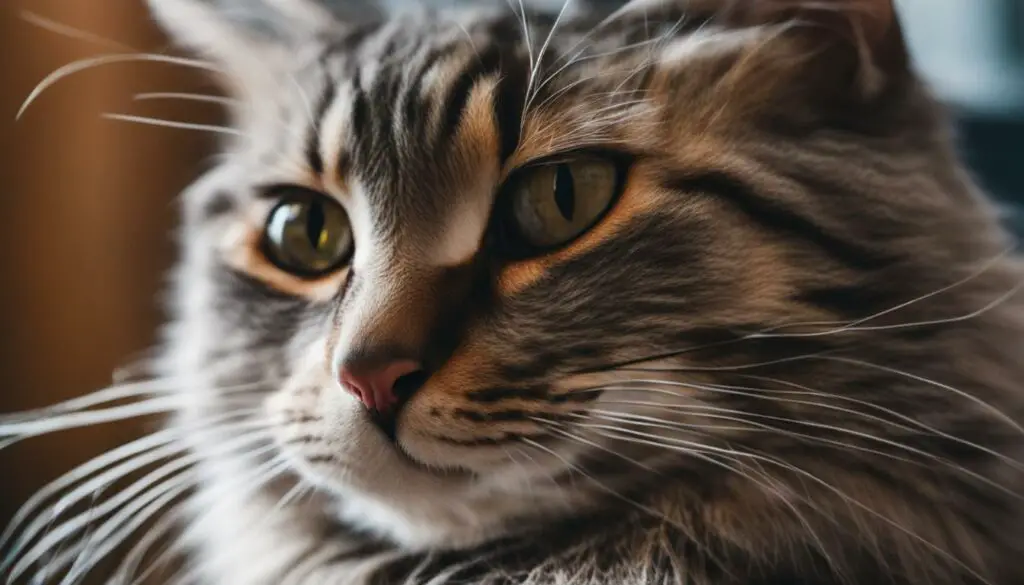
| Common Signs of a Stressed Cat | Strategies to Reduce Stress |
|---|---|
| Excessive grooming or hair loss | Provide a calm and secure environment |
| Changes in appetite or weight loss | Use pheromone diffusers or sprays |
| Urinating or defecating outside the litter box | Establish a consistent routine |
| Increased aggression or hiding behavior | Provide interactive toys and playtime |
| Overly clingy behavior or withdrawal | Avoid sudden environmental changes |
Hormonal Imbalances and Bald Spots in Cats
Cat hair loss can be attributed to various factors, and one of them is hormonal imbalances. Hormones play a crucial role in the growth of a cat’s fur, and any excess or deficiency in these hormones can result in the development of bald spots. Hormonal hair loss in cats can occur due to a variety of reasons, including thyroid imbalances and certain reproductive phases.
A common cause of hormonal hair loss in cats is hypothyroidism, a condition where the thyroid gland does not produce enough thyroid hormone. This can lead to significant hair loss, including the formation of bald spots. Another hormonal imbalance that can contribute to hair loss in cats is hyperthyroidism, which is the overproduction of thyroid hormone. Similarly, cats that are pregnant or lactating may experience temporary hair loss due to hormonal changes during this period.
It’s important to note that hormonal hair loss in cats can vary in severity and duration. Some cats may experience mild and temporary hair loss, while others may have more extensive and persistent bald spots. Consulting with a veterinarian is crucial in diagnosing and treating hormonal imbalances to restore hair growth and ensure the overall health of the cat.
To better understand the hormonal imbalances and their impact on hair loss in cats, refer to the table below:
| Hormonal Imbalance | Causes | Effects on Hair |
|---|---|---|
| Hypothyroidism | Inadequate thyroid hormone production | Significant hair loss, including bald spots |
| Hyperthyroidism | Excess thyroid hormone production | Potential hair loss and thinning |
| Pregnancy/Lactation | Hormonal changes during reproductive phases | Temporary hair loss in certain areas |
Proper diagnosis and treatment of these hormonal imbalances can help promote hair regrowth and improve the overall well-being of the cat. Veterinary guidance is crucial in determining the appropriate treatment options, which may include medication or hormonal therapies tailored to the specific needs of the cat.
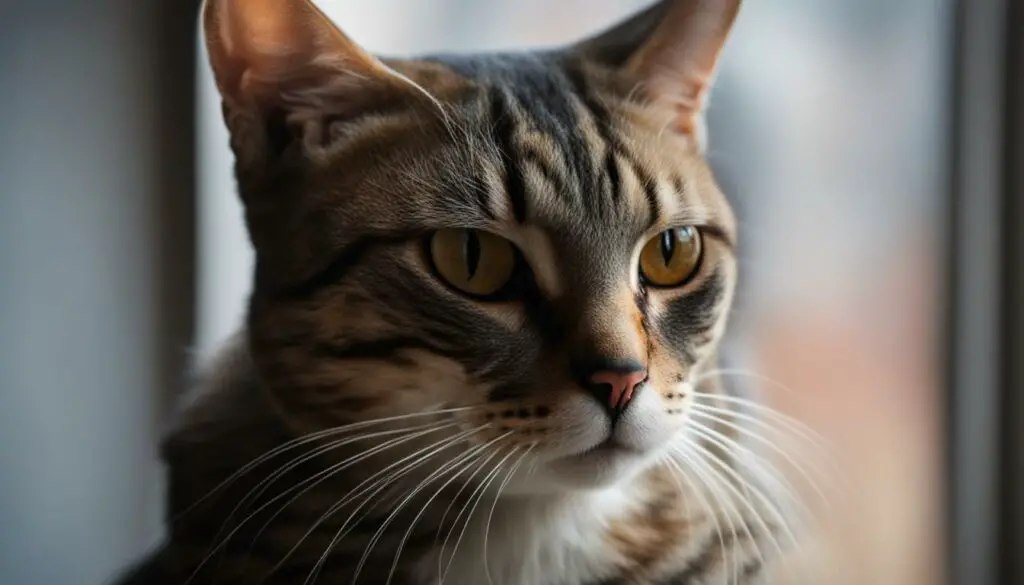
Bald Spots and Hormonal Imbalances: A Closer Look
When a cat experiences hair loss due to hormonal imbalances, it’s important to pay attention to the specific location and pattern of bald spots. Hypothyroidism, for example, may result in symmetrical hair loss on both sides of the body, while hyperthyroidism can lead to hair thinning and loss throughout the cat’s coat.
Additionally, hormonal hair loss in pregnant or lactating cats is often temporary and localized to specific areas such as the abdomen or mammary glands. These hormonal changes are a natural part of the reproductive cycle and typically resolve after the cat has finished nursing her kittens.
Regular monitoring and follow-up with a veterinarian are essential to ensure that the hormonal imbalances are properly managed and any associated hair loss is effectively addressed. With appropriate care, treatment, and attention to the hormonal needs of the cat, hair regrowth can be promoted, and bald spots can be minimized or eliminated.
Poor Health and Nutrition Impacting Cat Hair Loss
When it comes to cat hair loss, poor health and nutrition can play a significant role. A cat’s overall well-being depends on a balanced diet and proper nutrition to support a healthy coat. Poor diet choices or underlying health issues can result in hair loss and other related problems.
Feeding your cat a high-quality, well-balanced diet is essential to maintain optimal health. Cats require specific nutrients, such as protein, vitamins, and minerals, to support the growth and maintenance of their fur. Inadequate nutrition can lead to a dull coat, excessive shedding, and even bald patches.
Additionally, certain health conditions can impact a cat’s hair growth and contribute to hair loss. Common health issues that can affect a cat’s coat include thyroid imbalances, autoimmune disorders, and skin infections. Regular veterinary check-ups are crucial in identifying and addressing these underlying health concerns.
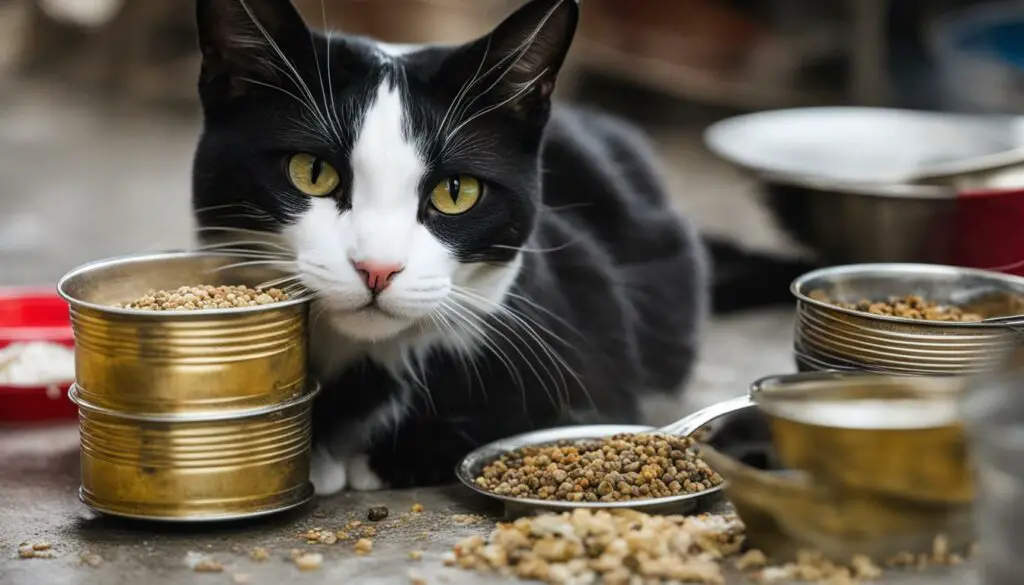
Key points:
- A balanced diet and proper nutrition are essential for a cat’s overall health and the maintenance of a healthy coat.
- Poor diet choices can result in hair loss and other coat-related problems.
- Underlying health issues can impact a cat’s hair growth and contribute to hair loss.
- Regular veterinary check-ups are crucial in identifying and addressing underlying health concerns.
Treating Cat Hair Loss: Diagnosis and Solutions
If you notice that your cat is experiencing hair loss, it’s important to seek veterinary care for a proper diagnosis and appropriate treatment. A veterinarian will be able to identify the underlying cause of the hair loss and develop a tailored treatment plan to address it.
The diagnosis process may involve a thorough examination of your cat’s skin, fur, and overall health. The veterinarian may also perform tests such as blood work, skin scrapings, or allergy testing to determine the specific cause of the hair loss. Once the cause is identified, treatment options can be discussed.
Treatment for cat hair loss can vary depending on the underlying cause. In some cases, medication may be prescribed to address infections, allergies, or hormonal imbalances. Dietary changes or supplements may also be recommended to improve your cat’s overall health and promote hair regrowth. Parasite control measures may be necessary if fleas or mites are causing the hair loss.
It’s important to follow the veterinarian’s recommendations and monitor your cat’s progress closely. Hair regrowth can take time, and it may not be possible to completely reverse the hair loss in certain cases. Regular follow-up appointments with the veterinarian will help ensure that the chosen treatment plan is effective and can be adjusted if needed.
Table: Common Causes and Treatments for Cat Hair Loss
| Cause | Treatment |
|---|---|
| Skin infections | Medication to address the specific infection, such as antibiotics or antifungal agents |
| Allergies | Dietary changes, allergy medications, or immunotherapy |
| Hormonal imbalances | Hormone replacement therapy or other medications to balance hormone levels |
| Parasite infestations | Parasite control measures, such as topical or oral treatments |
| Stress or anxiety | Behavioral modifications to reduce stress, environmental enrichment, or anxiety medications |
| Poor nutrition | Dietary changes to ensure a balanced and nutritious diet |
“Proper diagnosis is crucial for effectively treating cat hair loss. Consultation with a veterinarian is necessary to identify the underlying cause and develop a tailored treatment plan.”
In addition to medical treatment, it’s important to provide a supportive and stress-free environment for your cat. Minimizing sources of stress, providing plenty of mental and physical stimulation, and maintaining a consistent routine can help promote overall well-being and improve your cat’s hair regrowth.
Remember, every cat is unique, and the treatment plan that works for one may not work for another. By working closely with your veterinarian and following their guidance, you can help your cat regain a healthy and lustrous coat.
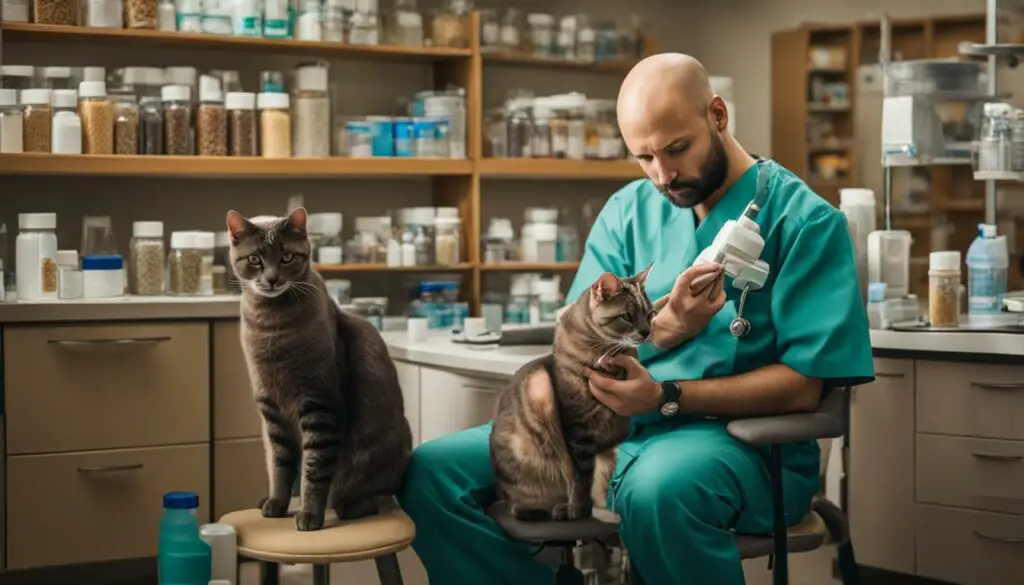
Cat Hair Loss in Different Seasons
Cats naturally shed their fur throughout the year, with increased shedding occurring during the summer and autumn months, known as the cat moulting season. During these seasons, cats experience a shedding process where their old, damaged, or excess fur is replaced with a new coat. This shedding helps regulate their body temperature and prepares them for the changing weather conditions.
The summer cat shedding is particularly noticeable as cats tend to shed their heavier winter coat to adapt to the warmer temperatures. This shedding process helps them stay cool and comfortable during the hot months. As a result, you may find more loose fur around your home during summer cat shedding.
It’s important to note that if the hair loss is evenly distributed throughout the body without the appearance of bald patches, it is a normal part of a cat’s shedding process. However, if you notice excessive hair loss, bald patches, or other concerning symptoms, it’s important to consult with a veterinarian to rule out any underlying health issues.
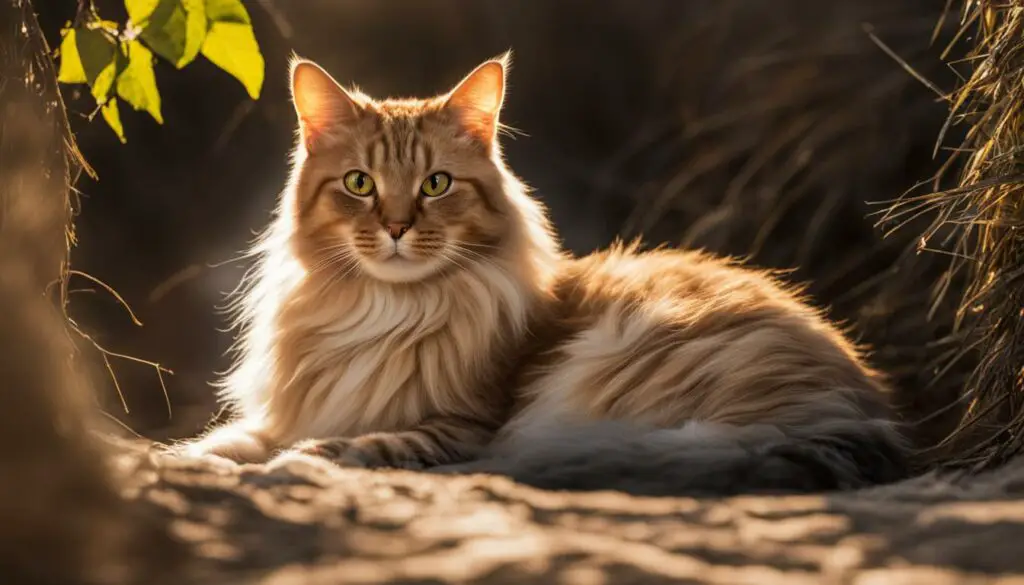
| Season | Characteristic |
|---|---|
| Summer | Increased shedding to adapt to warmer temperatures. |
| Autumn | Transition from summer coat to a thicker winter coat. |
| Winter | Maintaining a thick coat for insulation. |
| Spring | Shedding the winter coat to prepare for the warmer weather. |
Baldness in Cats: When to Seek Veterinary Care
If you notice bald patches or significant hair loss in your cat, it’s important to seek veterinary care. A bald cat may require specialized care and attention to ensure their well-being. Here are some key reasons why veterinary care is crucial for bald cats:
1. Proper Diagnosis and Treatment
A veterinarian can properly diagnose the underlying cause of hair loss in your bald cat. There are various factors that can contribute to hair loss, including skin conditions, allergies, hormonal imbalances, and stress. By identifying the specific cause, the veterinarian can develop an appropriate treatment plan to address the issue efficiently.
2. Tailored Care and Management
Bald cats often have unique care requirements. For example, their hairless skin may be more sensitive and prone to sunburn or dryness. A veterinarian can provide guidance on how to properly care for your bald cat’s skin, including recommending appropriate moisturizers or sun protection. They can also advise on specialized diets or supplements that promote healthy skin and coat.
3. Preventive Measures
Veterinary care for a bald cat goes beyond treating existing hair loss. A veterinarian can help you understand potential triggers or risk factors that may contribute to further hair loss. With their guidance, you can take preventive measures to minimize the chances of future hair loss, such as managing stress, addressing allergies, or implementing parasite control measures.
By seeking veterinary care, you can ensure that your bald cat receives the necessary attention and support to maintain their overall health and well-being. Remember, every bald cat is unique, and their specific care requirements may vary. Regular consultations with a veterinarian will help you provide the best possible care for your beloved hairless feline friend.
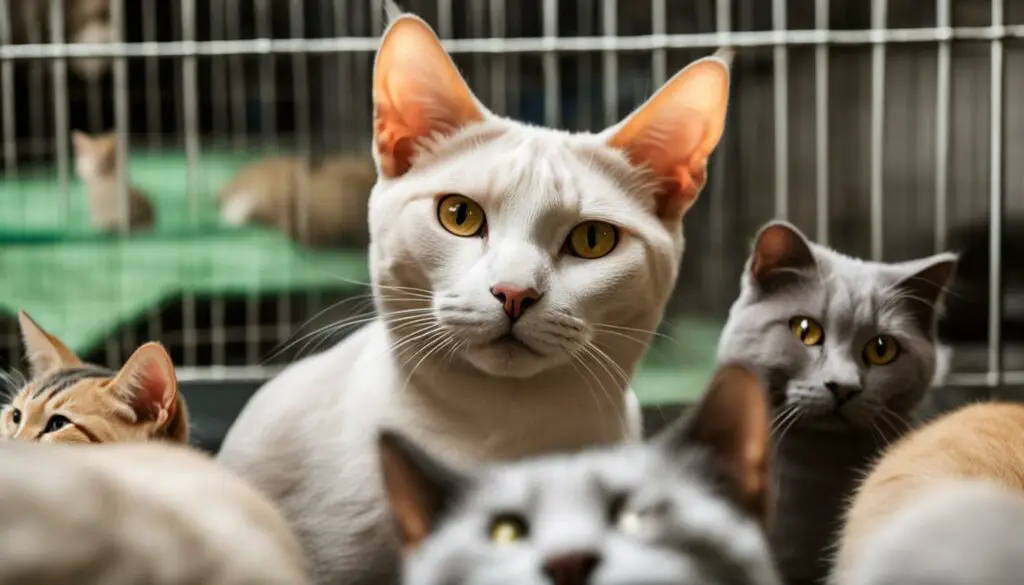
Understanding Bald Patches on Cats: Appearance and Concerns
Bald patches on cats can be a cause for concern for many pet owners. These areas of hair loss can vary in size and location, ranging from small patches to more extensive baldness. The appearance of bald patches on cats can be accompanied by scabs, particularly when caused by external parasites such as fleas.
Observing the location and nature of the bald patches can help identify potential causes. If the hair loss is localized or accompanied by scabs, it may be an indication of a specific problem. However, it’s important to note that the presence of bald patches does not always signify a serious issue, as cats naturally shed their fur throughout the year.
If you notice bald patches on your cat, it’s essential to pay attention to any accompanying symptoms or changes in behavior. Consultation with a veterinarian can help determine the cause of the hair loss and provide appropriate treatment or management strategies. Early intervention is key to addressing any underlying issues and ensuring the well-being of your feline companion.
Possible Causes of Bald Patches on Cats:
- External parasites, such as fleas or mites
- Overgrooming due to stress or anxiety
- Allergies to certain substances or environmental factors
- Fungal infections, such as ringworm
- Thyroid problems or hormonal imbalances
- Genetic conditions or underlying diseases
Identifying the specific cause of the bald patches is crucial for implementing appropriate treatment. This may involve parasite control measures, stress reduction techniques, allergy management, antifungal treatments, or addressing hormonal imbalances. Consulting with a veterinarian will ensure an accurate diagnosis and tailored treatment plan for your cat’s specific needs.
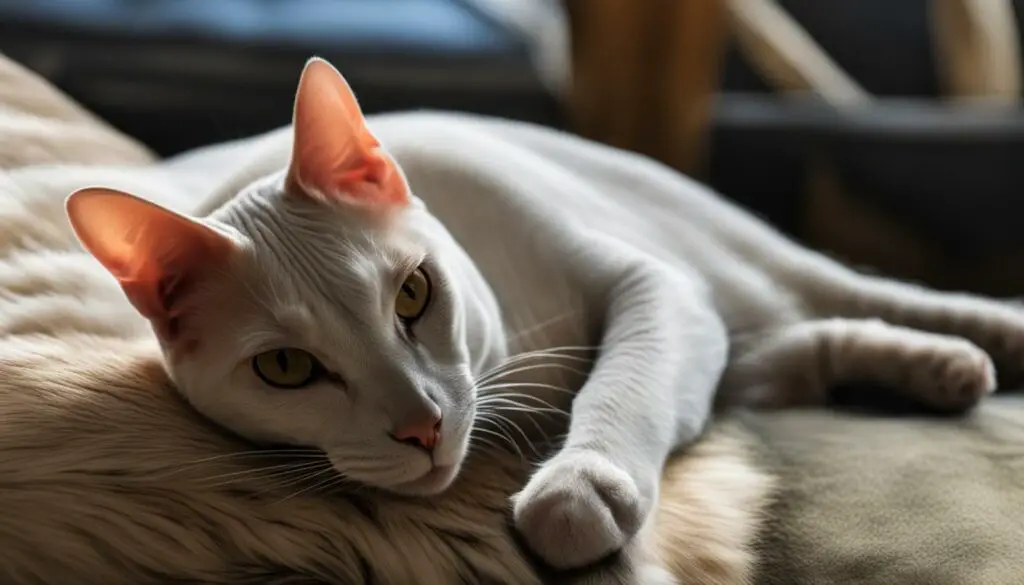
Table: Comparing Common Causes of Bald Patches on Cats
| Cause | Description | Treatment |
|---|---|---|
| External parasites | Fleas, mites, or ticks infesting the cat’s fur | Parasite control measures and preventive treatments |
| Overgrooming | Excessive licking or biting of fur due to stress or anxiety | Stress reduction techniques and behavioral modifications |
| Allergies | Reactions to certain substances or environmental factors | Identification and avoidance of allergens, medication, or immunotherapy |
| Fungal infections | Ringworm or other fungal infections affecting the skin | Antifungal treatments and necessary hygiene measures |
| Thyroid problems | Imbalances in thyroid hormone levels | Medication and management of thyroid function |
| Genetic conditions or diseases | Inherited disorders or underlying health issues | Supportive care and management of specific conditions |
Common Causes of Bald Patches on Cats
When your beloved furry feline develops bald patches, it can be concerning. Understanding the common causes of bald patches on cats is essential to address the issue effectively. Here are some of the primary factors that can contribute to bald patches on cats:
- Fleas and Parasites: Fleas are a common culprit when it comes to bald patches on cats. These pesky parasites can cause intense itching, leading your cat to excessively scratch and groom, resulting in hair loss.
- Overgrooming: Cats, especially when stressed or anxious, may engage in overgrooming behavior. Excessive licking and biting of their fur can lead to bald patches. It’s important to identify and address the underlying source of stress to prevent further hair loss.
Other potential causes of bald patches on cats include allergies, ringworm or fungal infections, thyroid problems, and genetic conditions. Allergies can cause cats to excessively itch and scratch, leading to hair loss in affected areas. Ringworm, a fungal infection, can cause circular bald patches with scaly skin. Thyroid problems, such as hyperthyroidism or hypothyroidism, can result in hair loss. Certain genetic conditions may also contribute to permanent hair loss in specific areas.
Proper diagnosis by a veterinarian is crucial to accurately identify the cause of your cat’s bald patches. Once the underlying cause is determined, appropriate treatment and management strategies can be implemented to address the issue and promote hair regrowth. Consulting with a veterinarian is recommended to develop a tailored plan for your cat’s specific needs.
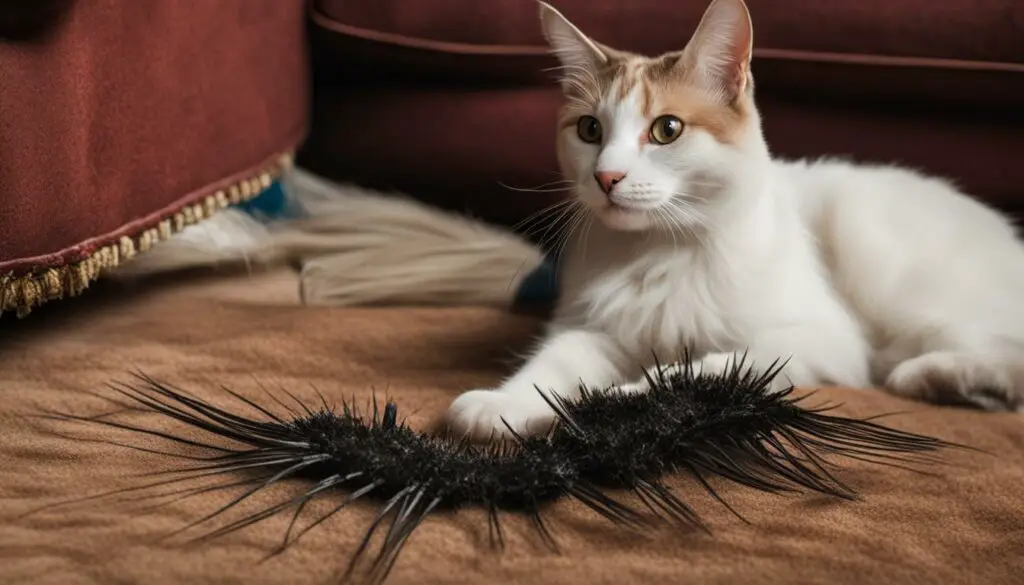
Table: Common causes of bald patches on cats
| Cause | Description |
|---|---|
| Fleas and Parasites | Infestation of fleas or other external parasites can cause intense itching and self-inflicted hair loss. |
| Overgrooming | Excessive grooming due to stress or anxiety can lead to bald patches as a result of vigorous licking and biting. |
| Allergies | Allergic reactions to certain substances can provoke itching and scratching, resulting in hair loss. |
| Ringworm or Fungal Infections | Fungal infections like ringworm can cause circular bald patches with scaly skin. |
| Thyroid Problems | Imbalances in thyroid hormones, such as hyperthyroidism or hypothyroidism, can contribute to hair loss in cats. |
| Genetic Conditions | Certain genetic conditions may lead to permanent hair loss in specific areas of a cat’s body. |
Fleas and Bald Patches on Cats
Fleas are a common external parasite that can cause significant discomfort and hair loss in cats. These tiny insects infest the cat’s fur, biting and feeding on their blood. The resulting itching and irritation can lead to excessive scratching and grooming, resulting in the development of bald patches.
“Fleas can be a nightmare for both cats and pet owners. Their relentless biting causes intense itching, causing cats to scratch and chew at their fur. It’s crucial to promptly address flea infestations to prevent further hair loss and discomfort for your furry friend.” – Dr. Emily, Veterinarian
To treat fleas and prevent bald patches in cats, it’s essential to use veterinarian-recommended flea treatments, such as spot-on treatments or oral medications. Additionally, thorough cleaning of the environment and regular vacuuming can help eliminate fleas and their eggs from your cat’s surroundings.
Treating Bald Patches on Cats: Addressing Underlying Causes
If your cat is experiencing bald patches, it’s important to identify and address the underlying causes to promote hair regrowth and ensure their overall well-being. Treatment for bald patches on cats may vary depending on the specific cause, so consulting with a veterinarian is crucial for proper diagnosis and tailored treatment plans.
One common cause of bald patches in cats is overgrooming, which can be a result of stress or anxiety. To address this, it’s important to create a calm and stimulating environment for your cat, providing them with toys, scratching posts, and engaging in interactive playtime. Additionally, using pheromone-based sprays or diffusers can help reduce stress levels. If your cat’s overgrooming is severe, your veterinarian may recommend behavioral therapy or medication.
Allergies can also lead to bald patches in cats. Identifying the specific allergen can be challenging, but a hypoallergenic diet or elimination diet under veterinary supervision may help pinpoint the cause. Your veterinarian may also recommend allergy testing or antihistamines to manage your cat’s allergies. Implementing environmental modifications, such as using hypoallergenic bedding or air purifiers, can also provide relief.
| Treatment Options for Bald Patches on Cats | |
|---|---|
| Underlying Cause | Treatment Options |
| Overgrooming | Environmental enrichment, behavior modification, medication |
| Allergies | Hypoallergenic diet, allergy testing, antihistamines, environmental modifications |
| Parasites | Parasite control measures, such as topical treatments or medications |
| Fungal Infections | Antifungal treatments, such as medicated shampoos or oral medications |
| Hormonal Imbalances | Hormone replacement therapy, supplementation |
| Nutritional Deficiencies | Diet adjustment, nutritional supplements |
Note: Treatment options may vary depending on the individual cat’s condition and the veterinarian’s recommendation.
By addressing the underlying causes of bald patches in cats and following the appropriate treatment plan, you can help promote hair regrowth and improve your feline companion’s overall health and happiness. Regular follow-up visits with your veterinarian will ensure that progress is monitored and any necessary adjustments to the treatment plan are made. Remember, each cat is unique, so what works for one may not work for another. With patience, care, and professional guidance, you can help your cat regain their beautiful coat and confidence.
Will Hair Regrow on Bald Patches in Cats?
One of the most common questions pet owners have when their cats experience hair loss is whether the hair will regrow on bald patches. The answer largely depends on the underlying cause of the hair loss and the effectiveness of the treatment provided. In many cases, once the cause is addressed and appropriate treatment is administered, hair can regrow on the bald patches.
It’s important to note that the regrowth process may take time and vary from cat to cat. Some cats may start to show signs of hair regrowth within a few weeks, while others may take several months. Patience is key, and it’s crucial to continue following the prescribed treatment plan and regularly consult with a veterinarian to monitor progress.
However, it’s important to understand that certain genetic conditions or scars may result in permanent hair loss. In such cases, the hair may not regrow on the affected areas. It’s best to consult with a veterinarian to determine the potential for hair regrowth based on the specific underlying cause of the bald patches.
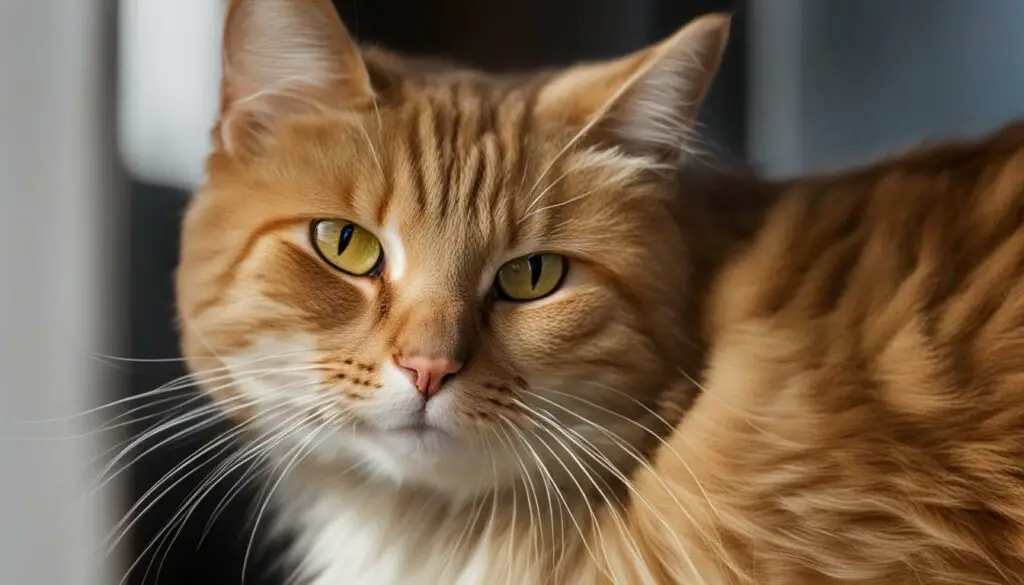
Promoting Hair Regrowth in Cats
While the process of hair regrowth in cats primarily relies on treating the underlying cause, there are some steps you can take to support the regrowth process:
- Ensure your cat receives a balanced and nutritious diet, as proper nutrition plays a vital role in promoting healthy hair growth.
- Keep your cat’s stress levels low and provide a calm and nurturing environment to help alleviate stress-induced hair loss.
- Regularly groom your cat to remove dead hair and stimulate the skin, which can help promote new hair growth.
By following these steps and working closely with your veterinarian, you can increase the chances of successful hair regrowth on bald patches in your cat.
Seeking Veterinary Care for Cat Hair Loss
When it comes to cat hair loss, seeking veterinary care is crucial. Veterinarians with expertise in cat dermatology can provide accurate diagnosis, develop tailored treatment plans, and offer guidance on preventive measures. Regular visits to the vet can help address any concerns and ensure the overall health and well-being of your cat.
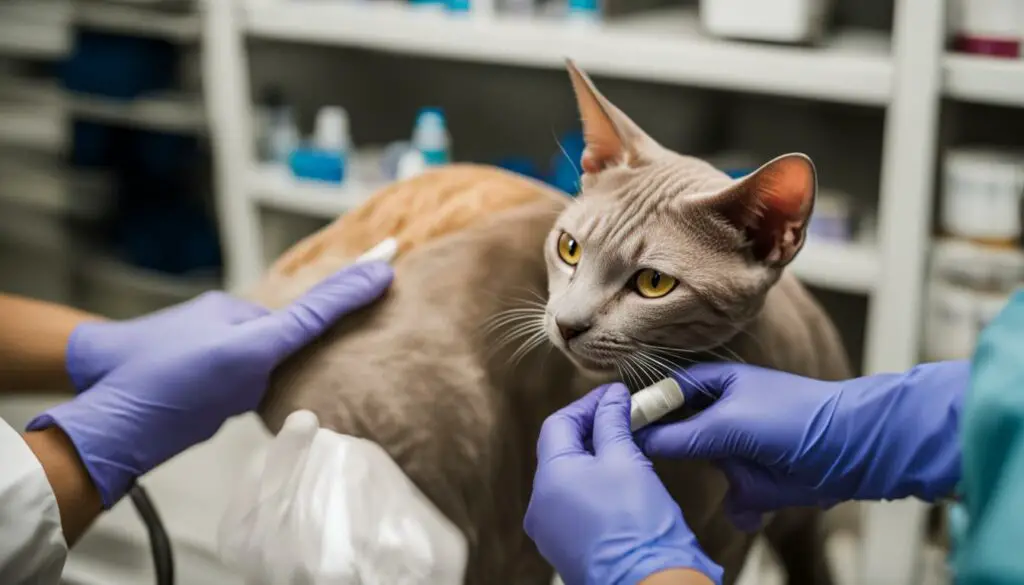
Visiting a veterinarian specializing in cat dermatology can provide several benefits. These professionals have in-depth knowledge of feline skin conditions and the underlying causes of hair loss. They can conduct thorough examinations to identify the specific cause of your cat’s hair loss and develop an appropriate treatment plan. Whether it’s treating a skin infection, managing allergies, or addressing hormonal imbalances, a veterinary dermatologist can provide specialized care to promote hair regrowth and improve your cat’s overall health.
Furthermore, seeking veterinary care for cat hair loss can help prevent potential complications. Hair loss can be a symptom of underlying health issues, such as infections or metabolic disorders. A veterinarian can diagnose and treat these conditions early, preventing them from progressing and causing further harm to your cat’s well-being. Additionally, they can provide guidance on proper nutrition, grooming techniques, and preventative measures to maintain your cat’s coat health and prevent future instances of hair loss.
Conclusion
The cat with a bald head, also known as a hairless cat, is a fascinating and unique breed that has captured the hearts of pet lovers all over the United States. With their distinct appearance and captivating charm, these bald cats, particularly the well-known Sphynx breed, have become a favorite among many cat enthusiasts.
While baldness in cats may be their defining characteristic, it’s important to understand that hair loss can occur due to various factors. Skin conditions, stress, hormonal imbalances, poor health, and nutrition can all contribute to a cat’s hair loss. Identifying the underlying cause is essential in developing an effective treatment plan and ensuring the well-being of your feline companion.
Seeking veterinary care is crucial when dealing with cat hair loss. A veterinarian specializing in pet dermatology can provide accurate diagnosis, tailored treatment plans, and invaluable guidance on preventive measures. Regular visits to the vet will aid in monitoring the progress of hair regrowth and overall health of your bald-headed cat.
With proper care, attention, and veterinary support, a hairless cat can thrive and bring joy to your household. So, if you’re considering adopting or already have a cat with a bald head, embrace their uniqueness and provide them with the love and care they need to flourish.
FAQ
What causes cat hair loss?
Cat hair loss can be caused by various factors, including skin conditions, infections, allergies, hormonal imbalances, poor health, and nutrition.
What are the symptoms of cat hair loss?
Symptoms of cat hair loss may include bald patches on the skin, excessive grooming, and itching.
When should I consult a vet for cat hair loss?
It’s important to consult a veterinarian to diagnose the underlying cause of cat hair loss and provide appropriate treatment.
Can skin conditions contribute to cat hair loss?
Yes, cats can develop skin conditions such as infections, parasites, or allergies that can lead to hair loss.
Can stress cause hair loss in cats?
Yes, just like humans, cats can experience hair loss due to stress or anxiety.
How do hormonal imbalances contribute to hair loss in cats?
Hormonal imbalances can lead to bald spots in cats, as specific hormones are responsible for hair growth.
How does poor health and nutrition impact cat hair loss?
Poor diet, underlying diseases, and general poor health can result in hair loss in cats.
What treatments are available for cat hair loss?
Treatment options for cat hair loss may include medication, diet adjustments, parasite control, stress reduction, and addressing underlying health issues.
Is it normal for cats to shed their fur?
Yes, cats naturally shed their fur throughout the year, with increased shedding during specific seasons.
When should I seek veterinary care for bald patches on my cat?
If you notice bald patches or significant hair loss in your cat, it’s important to seek veterinary care to diagnose and address any underlying issues.
What are the common causes of bald patches on cats?
Common causes of bald patches on cats include external parasites, overgrooming due to stress, allergies, infections, hormonal imbalances, and genetic conditions.
How can I treat bald patches on my cat?
Treatment for bald patches on cats involves addressing the underlying cause, such as parasite control, stress reduction, allergy management, and appropriate medical treatments.
Will hair regrow on bald patches in cats?
In many cases, hair can regrow on bald patches in cats after appropriate treatment is administered. However, some genetic conditions or scars may result in permanent hair loss.
When should I seek veterinary care for cat hair loss?
It is important to seek veterinary care for proper diagnosis, treatment, and management of cat hair loss.
How can I best care for a cat with a bald head?
Providing proper care and veterinary support is essential for maintaining the health and well-being of a cat with a bald head.
Source Links
- https://www.purina.co.uk/articles/cats/health/skin-fur-ears/hair-loss-in-cats
- https://www.argospetinsurance.co.uk/we-talk-pet/bald-patches-on-cats-what-are-the-reasons-for-them/
- https://knutsfordvetsurgery.co.uk/why-does-my-cat-have-bald-patches/

